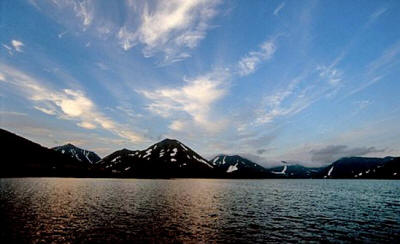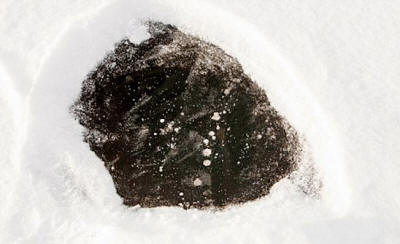|

by Jonathan Benson
December 22, 2011
from
NaturalNews Website
When a Russian team recently stumbled upon a few methane "fountains"
releasing large amounts of methane gas from shallow arctic waters
directly into the atmosphere, they had no idea that there were
hundreds, if not thousands, more.
The
UK's Daily Mail reports that the
Russian research vessel Academician Lavrentiev has identified at
least 100 large methane plumes in the East Siberian Arctic Shelf
that are
releasing high amounts of the methane gas
into the environment.
"We found more than 100 fountains,
some more than a kilometer (just over three-fifths of a mile)
across," said Dr. Igor Semiletov, who was involved in the
discovery.
"These are methane fields on a scale
not seen before. The emissions went directly into the
atmosphere."
Under normal circumstances, methane
leaks deep in the ocean oxidize long before they reach the surface.
Microbes in both marine and freshwater
sediments convert methane into carbon dioxide on its way up to the
ocean surface. But since the area where the methane fountains have
been discovered is in relatively shallow water, there is not enough
time for this conversion to take place.
According to the National
Science Foundation (NSF), methane gas is 30 times more potent,
gram for gram, than carbon dioxide in affecting the climate.
If true, this means that continuous,
high-level releases of this gas from melting "permafrost" under the
sea has the potential to rapidly alter normal climate conditions -
and there really is nothing anyone can do about it.
"Earlier we found torch or
fountain-like structures like this," added Semiletov about prior
methane release discoveries in the area. "This is the first time
that we've found continuous, powerful and impressive seeping
structures, more than 1,000 meters (about 3,280 feet) in
diameter. It's amazing."
On the flip side, some question the
validity of the theory that methane contributes to climate
change on any significant level, alleging that, like carbon
dioxide, it is not much of a threat to the planet.
Research conducted by Dr. Joel
Kauffman, Emeritus Professor of Chemistry at The University of
the Sciences in Philadelphia, for instance,
actually found that methane is
not really the active "greenhouse gas" that some claim it is.
-
A Greenhouse Gas 30 times More Potent Than
Carbon Dioxide -
'Fountains' of Methane
...1,000m
Across Erupt from Arctic Ice
13 December 2011
from
DailyMail Website
|
'Methane fields on a scale
not seen before'.
More than 100 fountains, but could be 'thousands'.
Could cause rapid climate change. |
The Russian research vessel Academician Lavrentiev conducted a
survey of 10,000 square miles of sea off the coast of eastern
Siberia.
They made a terrifying discovery - huge plumes of methane bubbles
rising to the surface from the seabed.
'We found more than 100 fountains,
some more than a kilometer across,' said Dr Igor Semiletov,
'These are methane fields on a scale not seen before. The
emissions went directly into the atmosphere.'

Far East Siberia
The melting of
'permafrost' under the sea has led
to huge releases of
methane - far more abrupt and intense than anything on land
Earlier research conducted by
Semiletov's team had concluded that the amount of methane currently
coming out of the East Siberian Arctic Shelf is comparable to the
amount coming out of the entire world’s oceans.
Now Semiletov thinks that could be an underestimate.
The melting of the arctic shelf is melting 'permafrost' under the
sea, which is releasing methane stored in the seabed as methane gas.
These releases can be larger and more abrupt than any land-based
release.
The East Siberian Arctic Shelf is a
methane-rich area that encompasses more than 2 million square
kilometers of seafloor in the Arctic Ocean.

Methane bubbles
trapped in ice
Normally, bubbles
from the seabed turn into carbon dioxide before reaching the
surface,
but the East Siberian
Arctic Shelf is so shallow the methane travels directly into the
atmosphere
'Earlier we found torch or fountain-like structures like this,'
Semiletov told the Independent. 'This is the first time that
we've found continuous, powerful and impressive seeping
structures, more than 1,000 meters in diameter. It's amazing.'
'Over a relatively small area, we found more than 100, but over
a wider area, there should be thousands of them.'
Semiletov's team used seismic and
acoustic monitors to detect methane bubbles rising to the surface.
Scientists estimate that the methane trapped under the ice shelf
could lead to extremely rapid climate change. Current average
methane concentrations in the Arctic average about 1.85 parts per
million, the highest in 400,000 years. Concentrations above the East
Siberian Arctic Shelf are even higher.
The shelf is shallow, 50 meters or less in depth, which means it has
been alternately submerged or above water, depending on sea levels
throughout Earth’s history.
During Earth’s coldest periods, it is a frozen arctic coastal plain,
and does not release methane.
As the planet warms and sea levels rise, it is inundated with
seawater, which is 12-15 degrees warmer than the average air
temperature.
In deep water, methane gas oxidizes into carbon dioxide before it
reaches the surface. In the shallows of the East Siberian Arctic
Shelf, methane simply doesn’t have enough time to oxidize, which
means more of it escapes into the atmosphere.
That, combined with the sheer amount of methane in the region, could
add a previously uncalculated variable to climate models.
|


